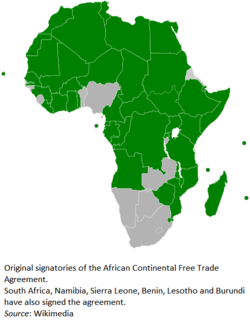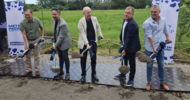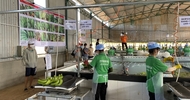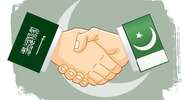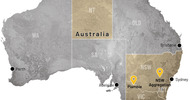Middle eastern investment in Africa: A means to improve gulf food security?
Key Points
- Tariffs and other trade barriers between African countries are expected to fall if the African Continental Free Trade Area is established.
- Africa will require increased investment in infrastructure, if it is to obtain the greatest benefit from the changes to its trading regime.
- Gulf states, while already strong investors in the sub-Saharan tourism and service industries, are well positioned to increase their investment in African infrastructure.
- Gulf countries could take advantage of those infrastructure requirements and set the foundation for further investment in more industry-focused sectors, like agribusiness, to bolster their food security.
Summary
The food security of the Gulf states is heavily dependent on foreign imports. Europe and the Americas have been the traditional markets supplying food to them, but recent developments in sub-Saharan Africa may encourage Gulf investors to embrace potential opportunities in Africa.
The African Continental Free Trade Agreement (AfCFTA) is likely to produce a hunger for infrastructure and indicates a possible move within Africa to boost internal trade. Gulf states will be looked upon as potential investors in the infrastructure needed to make this policy vision a working reality. Gulf states have typically avoided committing to infrastructure projects on the continent, however, opportunities abound. Helping Africa realise its trading potential could open Gulf investors to agribusiness opportunities on the continent and, in so doing, open a new agricultural market for Gulf states to exploit.
Analysis
Food imports into the Gulf states are expected to reach US$53.1 billion ($72.2 billion) by 2020. The changing dietary preferences of a population that is expected to reach 53.5 million by 2020, together with a decline in the groundwater tables across the Middle East, mean that food imports will be important for the continued growth of the region. According to Reuters, ‘Gulf oil-exporting states are buying farmland and agricultural assets abroad because of concern about their food security.’
The quality and the quantity of food supplies sourced from Europe or the Americas usually compel Gulf states to prioritise trade with those regions. Though this is largely still the case, Middle Eastern countries are also seeking to deepen trade links with sub-Saharan Africa. Indeed, the United Arab Emirates (UAE) and Saudi Arabia are already investing in ports, trade routes and other infrastructure projects of an economic or military nature in that region. Boosting trade traffic along the east coast of Africa is part of a ‘strategy to secure more points of access along the Horn of Africa and further inland, helping to increase trade with fast-growing economies like Ethiopia and tapping East Africa’s swelling consumer class.’
As stated in a previous Strategic Analysis Paper, African economic growth, broadly speaking, was very strong until around 2013. Consumer spending was up and investment in infrastructure echoed the commodity-fuelled growth sweeping a significant portion of the continent. Between 2014 and 2017, however, growth slowed to rates not seen in two decades. Nevertheless, by some accounts, Africa’s economic growth rates are now on a firm footing.
Agriculture is touted as an industry capable of employing the massive population that is expected to live in sub-Saharan Africa by 2050. Those who are optimistic about Africa’s long-term economic development suggest that other social developments and economic sectors, such as urbanisation, technological progress and manufacturing, will also generate employment opportunities for the continent. It does not come as a surprise, therefore, that the Gulf states are warming to the continent’s growth potential.
Another draw card energising Afro-Gulf economic linkages is the recent signing of the African Continental Free Trade Agreement (AfCFTA). It aims to create a ‘single continental market for goods and services, with free movement of business persons and investments.’ The size and fractured nature of intra-African trade has prevented many sub-Saharan countries from fully exploiting the gains that could be made.
AfCFTA presents two possible visions for the future economic development of Africa. Some commentators believe that corruption, poor infrastructure and past policy failures will dampen the benefits that consumers, business people and governments are supposed to experience thanks to the agreement. The optimists, on the other hand, believe that the AfCFTA has a role to play in nullifying those ailments and exploiting the benefits of intra-regional trade. They believe it can lower corruption and create more economic opportunities, which will eventually foster a brighter future for Africa. The agreement offers signatories the opportunity to increase agricultural production, manufacturing and trade. Without investments in infrastructure, however, this could remain a pipe dream. Gulf states have the money to provide the necessary infusion of capital, which could provide them with opportunities to build infrastructure and a multitude of other business projects.
There are immense business opportunities for Gulf states in sub-Saharan agriculture, provided the initial investments in infrastructure are made. Investors are looking for new markets, which has brought increased interest to the continent. As those African countries interested in greater intra-continental trade strive to achieve it, the Gulf states, among others, will endeavour to exploit this progress for their own economic benefit.
Measuring Gulf Investment in Overseas Agriculture
Unable to grow enough food domestically, Gulf investors have been paying more attention to Africa, mainly East Africa, as a potential long-term source of food. Countries on the Arabian Peninsula have tried to increase food self-sufficiency on a more local level, only to later abandon those efforts and look abroad for other options. For example, Saudi Arabia began growing its own wheat in the 1970s only to abandon that effort in 2008 when it realised that the venture had drained its aquifers. Around 85 to 90 per cent of the water used in Saudi Arabia during that time had gone into the agricultural sector. Population pressure and the depletion of water supplies meant that the only viable solution was to look overseas and establish a set of supply routes that could reliably deliver food supplies. Importing food is seen as a cheaper option, both economically and environmentally. The immense wealth of the Gulf states has resulted in a possible strategy of “infrastructure for food”. Improvements in both the prospects for better trade conditions and the investment environment have renewed the confidence levels of Gulf investors.
A number of Gulf states have a history of exploring market opportunities in other countries willing to supply agricultural products in return for investment. In 2008, at a roadshow for Pakistan’s agricultural sector, the UAE-based Emirates Investment Group, ‘stated that they had spent some two years researching the [Pakistani] agricultural and dairy industries and exploring the opportunities available.’ The Pakistani Government, under then-President Pervez Musharraf, offered interested investors, ‘99-year leases and unrestricted repatriation of all profits and produce, and a 100,000-strong security force, at a cost of $2 billion, to protect these investments.’ Similar projects followed suit. The UAE acquired around 16,000 hectares of land in Pakistani Balochistan in 2009. By 2011, Qatar Livestock had invested approximately US$1 billion ($1.35 billion) in corporate farming ventures in Pakistan.
Gulf states have shown that they are willing to use their petro-dollars to provide emerging markets with infrastructure in return for access to agricultural ventures or investment. Pakistan’s economic vision is centred on rapid industrialisation, electrification and infrastructure development projects that offer the possibility of contracts, partnerships and exchanges of expertise extending beyond agriculture. Gulf states have invested in that vision and consequently positioned themselves as beneficiaries.
The same model could soon be applied to African countries. Africa is by no means a risk-free investment location. Conflict and political violence are widespread, famine is a constant worry. These issues and a lack of good governance are not only challenges some African countries have to deal with themselves, but are serious issues that investors have to consider. Africa, provided the AfCFTA is ratified and security challenges are resolved, could be a new market replete with economic opportunities, agricultural or otherwise.
African Export-Led Growth
Exports proved to be a major asset for Africa before and after the global financial crisis (GFC) hit in 2008. Even though some commentators insist that Africa’s reliance on exports contributed to the hit its economies took during 2008 and then again around 2014, studies show that Africa came out of the 2008 crisis ‘faster than most other regions.’ Africa, with each passing downturn, has learned what needs to change in its trade structure, to ensure that African exports remain competitive.
For example, after the GFC, many commodity-rich exporter countries found that market diversification was just as important as resource diversification. Many realised that a reliance on one commodity for trade was very risky, given the possibility of price fluctuations. Trading with one market, however, doubled the risk, especially if demand for the product fell or the price plummeted.
Diversifying export products, while also promoting the exportation of those products to different markets, became an increasingly vital concern. While the vast majority of exports from sub-Saharan Africa go to Europe, China, India or the Americas, it was found there was potential for more trade and greater growth within Africa itself. For developing countries, exports ‘can serve as an important source of foreign exchange and a source of demand when the domestic market is small … exports generate efficiency and learning effects.’ Africa is seeking to improve its trade capabilities to benefit from those outcomes.
African countries are seeking to boost exports to their neighbours, before hopefully moving on to higher value export destinations like the US. Exports served Africa well in the first decade of the 21st century, by allowing commodity-focused economies to specialise in specific goods. The economic downturns that affected most of the continent in 2008 and 2014, concerned many people that export-led growth was not a healthy way of growing African economies. Export-focused growth contributed to a number of economic calamities in those years, but it also enabled Africa to not only recover, but advance, in the aftermath.
Trade has evolved in Africa, as it has across the globe, from something that simply involves the trading of items for commercial benefit, to a dynamic interaction that, in addition to the commercial benefit, involves the transfer of information and technology. In other words, trade is no longer solely about making money, but also gaining knowledge and access to new technology. This approach to trade began to appear the late 1980s and early 1990s and has gained influence in African countries seeking greater international and regional trade. If a country wants to progress economically, exports have to involve more than natural commodities. Through the AfCFTA, countries could offer tax incentives, remove barriers to trade, bolster job training and general education and make the transportation of goods, people and information more secure. This does not mean dismissing commodity-based exports, but instead using them in tandem with other technologies and products, to diversify exports and generate overall economic efficiency.
Part of this progress lies in expanding the scope and sophistication of intra-African trade. According to the Brookings Institute, ‘a pan-African market … could increase intra-Africa trade by about 52 per cent, resulting in an increase of African manufacturing exports.’ Boosting manufacturing would increase total African GDP and the number of people with a job, thereby helping to alleviate poverty. More than half of the world’s population will reside in Africa by 2050, so the need to maximise the employment options within both the agricultural and manufacturing sectors will be of vital importance. A trade regime that makes it easier and more economic to trade resource commodities and high-quality manufactures throughout the African continent and the Middle East and North Africa (MENA) region, could usher in a period of economic growth and political stability; the Gulf states could both contribute to and benefit from, that growth.
African Agriculture: A Gateway to Gulf Food Security?
African countries, eager to take advantage of the trading opportunities presented by the AfCFTA, may take measures to increase the size of their manufacturing sector. Infrastructure is needed to ensure that economic growth takes place. African countries may, therefore, put more effort into linking with Gulf investors, who could provide the capital needed to not only fund the construction of logistics nodes, but the domestic industrial base necessary to maintain them.
A number of African countries already possess a nascent industrial sector, or have a history of one, which could, with the right tutelage, evolve and grow. Some investors believe that African countries should look to infrastructure development and special economic zones as a way of expanding the present and long-term benefits of export-oriented growth. African countries should court both the financial and practical expertise of more developed countries, to make this vision a reality.
Historically, Gulf investments have usually gone to the service sector, rather than infrastructure development. African states seek investment in roads, storage units, ports and other major logistics centres. If they are able to fund these needs, Gulf states could establish themselves within African economies and exploit growth industries, such as agribusiness, both in Africa and at home.
Food security is a controversial factor in relations between African and Gulf states. Saudi Arabia – which is one of the more prolific investors in African agriculture – the UAE and Qatar, all have billions of dollars invested in African agriculture. Gulf land deals have faced scrutiny in the past when discouraging details emerged or investments failed to materialise. To boost their profile and their economic and agricultural clout in sub-Saharan Africa, Gulf states could give support to their African agricultural holdings by investing in what Africa both needs and wants: infrastructure.
Increased trade with the Gulf states is desirable to a number of African countries, something that is likely to be made easier by the implementation of the AfCFTA. They need infrastructure to facilitate trade; the Gulf investors have both the money and the interest in providing what they want, to better their own influence and image in the region. Infrastructure investment is a broad sector that Gulf states could eventually utilise to their own national benefit.
Growing food in other countries for the domestic market is becoming more important for Gulf countries, which is why they could make it part of their broader infrastructure plans for the region. If Gulf investors support African agribusiness, instead of simply engaging in “land grabbing”, they could stand to benefit from a potential growth industry. Not only would it broaden the channel for food supplies to the Gulf, but the importation of technology and infrastructure into Africa could be used to further boost agricultural and manufacturing exports. Africa needs infrastructure if its export-oriented growth strategy is to modernise, which is why Gulf states should, through the AfCFTA, work to provide infrastructure that could serve an agricultural purpose for both the Gulf and Africa itself.


